
Metamorphosis is a biological process by which an animal physically develops including birth transformation or hatching, involving a conspicuous and relatively abrupt change in the animal's body structure through cell growth and differentiation. Some insects, fish, amphibians, mollusks, crustaceans, cnidarians, echinoderms, and tunicates undergo metamorphosis, which is often accompanied by a change of nutrition source or behavior. Animals can be divided into species that undergo complete metamorphosis ("holometaboly"), incomplete metamorphosis ("hemimetaboly"), or no metamorphosis ("ametaboly").
Neoteny, also called juvenilization, is the delaying or slowing of the physiological, or somatic, development of an organism, typically an animal. Neoteny is found in modern humans compared to other primates. In progenesis or paedogenesis, sexual development is accelerated.

A larva is a distinct juvenile form many animals undergo before metamorphosis into their next life stage. Animals with indirect development such as insects, amphibians, or cnidarians typically have a larval phase of their life cycle.

Lepidoptera or lepidopterans is an order of winged insects that includes butterflies and moths. About 180,000 species of the Lepidoptera have been described, representing 10% of the total described species of living organisms, making it the second largest insect order with 126 families and 46 superfamilies. and one of the most widespread and widely recognizable insect orders in the world.
Hypermetamorphosis, or heteromorphosis, is a term used mainly in entomology; it refers to a class of variants of holometabolism, that is to say, complete insect metamorphosis. Hypermetamorphosis is exceptional in that some instars, usually larval instars, are functionally and visibly distinct from the rest. The differences between such instars usually reflect transient stages in the life cycle; for instance, one instar might be mobile while it searches for its food supply, while the following instar immediately sheds its locomotory organs and settles down to feed until it is fully grown and ready to change into the reproductive stage, which in turn, does not have the same nutritional requirements as the larvae.

In biology, a nymph is the immature form of some invertebrates, particularly insects, which undergoes gradual metamorphosis (hemimetabolism) before reaching its adult stage. Unlike a typical larva, a nymph's overall form already resembles that of the adult, except for a lack of wings. In addition, while a nymph moults, it never enters a pupal stage. Instead, the final moult results in an adult insect. Nymphs undergo multiple stages of development called instars.

Whiteflies are Hemipterans that typically feed on the undersides of plant leaves. They comprise the family Aleyrodidae, the only family in the superfamily Aleyrodoidea. More than 1550 species have been described.

Mayflies are aquatic insects belonging to the order Ephemeroptera. This order is part of an ancient group of insects termed the Palaeoptera, which also contains dragonflies and damselflies. Over 3,000 species of mayfly are known worldwide, grouped into over 400 genera in 42 families.

A pupa is the life stage of some insects undergoing transformation between immature and mature stages. Insects that go through a pupal stage are holometabolous: they go through four distinct stages in their life cycle, the stages thereof being egg, larva, pupa, and imago. The processes of entering and completing the pupal stage are controlled by the insect's hormones, especially juvenile hormone, prothoracicotropic hormone, and ecdysone. The act of becoming a pupa is called pupation, and the act of emerging from the pupal case is called eclosion or emergence.

An instar is a developmental stage of arthropods, such as insects, between each moult (ecdysis), until sexual maturity is reached. Arthropods must shed the exoskeleton in order to grow or assume a new form. Differences between instars can often be seen in altered body proportions, colors, patterns, changes in the number of body segments or head width. After shedding their exoskeleton (moulting), the juvenile arthropods continue in their life cycle until they either pupate or moult again. The instar period of growth is fixed; however, in some insects, like the salvinia stem-borer moth, the number of instars depends on early larval nutrition. Some arthropods can continue to moult after sexual maturity, but the stages between these subsequent moults are generally not called instars.
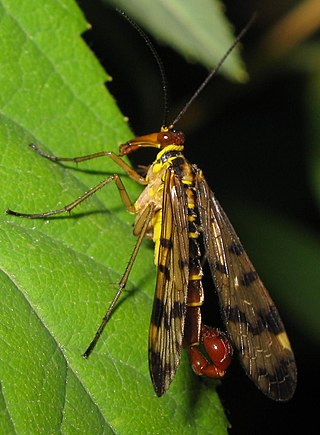
Holometabola, also known as Endopterygota, is a superorder of insects within the infraclass Neoptera that go through distinctive larval, pupal, and adult stages. They undergo a radical metamorphosis, with the larval and adult stages differing considerably in their structure and behaviour. This is called holometabolism, or complete metamorphism.
Larviform female is a biological phenomenon occurring in some insect species, where the females in the adult stage of metamorphosis resemble the larvae to various degrees, while the male appears more morphologically adult. The resemblance may mean the larviform female has the same coloring as the larvae and/or similar body plans, and may be the result of the female arresting development at earlier stages of ecdysis than males. The female may not pupate at all, as in Xenos vesparum. Typically, the female is wingless and generally larger than the male. Larviform females still reach sexual maturity. Larviform females occur in several insect groups, including most Strepsiptera and Bagworm moths, many elateroid beetles, and some gall midges.
Holometabolism, also called complete metamorphosis, is a form of insect development which includes four life stages: egg, larva, pupa, and imago. Holometabolism is a synapomorphic trait of all insects in the superorder Holometabola. Immature stages of holometabolous insects are very different from the mature stage. In some species the holometabolous life cycle prevents larvae from competing with adults because they inhabit different ecological niches. The morphology and behavior of each stage are adapted for different activities. For example, larval traits maximize feeding, growth, and development, while adult traits enable dispersal, mating, and egg laying. Some species of holometabolous insects protect and feed their offspring. Other insect developmental strategies include ametabolism and hemimetabolism.
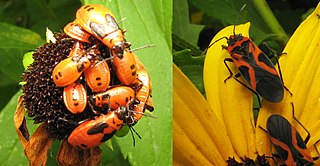
Hemimetabolism or hemimetaboly, also called partial metamorphosis and paurometabolism, is the mode of development of certain insects that includes three distinct stages: the egg, nymph, and the adult stage, or imago. These groups go through gradual changes; there is no pupal stage. The nymph often has a thin exoskeleton and resembles the adult stage but lacks wings and functional reproductive organs. The hemimetabolous insects differ from ametabolous taxa in that the one and only adult instar undergoes no further moulting.

The Exopterygota, also known as Hemimetabola, are a superorder of insects of the subclass Pterygota in the infraclass Neoptera, in which the young resemble adults but have externally developing wings. They undergo a modest change between immature and adult, without going through a pupal stage. The nymphs develop gradually into adults through a process of moulting.

The name Apterygota is sometimes applied to a former subclass of small, agile insects, distinguished from other insects by their lack of wings in the present and in their evolutionary history; notable examples are the silverfish, the firebrat, and the jumping bristletails. Their first known occurrence in the fossil record is during the Devonian period, 417–354 million years ago. The group Apterygota is not a clade; it is paraphyletic, and not recognized in modern classification schemes. As defined, the group contains two separate clades of wingless insects: Archaeognatha comprises jumping bristletails, while Zygentoma comprises silverfish and firebrats. The Zygentoma are in the clade Dicondylia with winged insects, a clade that includes all other insects, while Archaeognatha is sister to this lineage.
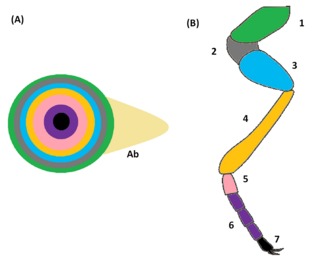
An imaginal disc is one of the parts of a holometabolous insect larva that will become a portion of the outside of the adult insect during the pupal transformation. Contained within the body of the larva, there are pairs of discs that will form, for instance, the wings or legs or antennae or other structures in the adult. The role of the imaginal disc in insect development was first elucidated by Jan Swammerdam.
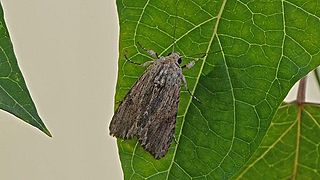
Spodoptera eridania is a moth that is known to be a pest. They are one of the most important defoliators in the tropical and subtropical regions of the western hemisphere that feed heavily on plants while they are young, often resulting in skeleton leaves on their food plants. They are also heavy feeders on tomato in Florida. There is a lot of development in producing pesticides against the S. eridania, specifically a neem-based pesticide that can result in smaller and prolonged development. The wingspan is 33–38 mm. Adults are on wing year-round. The larvae feed on various weeds but prefer Amaranthus species and Phytolacca americana.

The external morphology of Lepidoptera is the physiological structure of the bodies of insects belonging to the order Lepidoptera, also known as butterflies and moths. Lepidoptera are distinguished from other orders by the presence of scales on the external parts of the body and appendages, especially the wings. Butterflies and moths vary in size from microlepidoptera only a few millimetres long, to a wingspan of many inches such as the Atlas moth. Comprising over 160,000 described species, the Lepidoptera possess variations of the basic body structure which has evolved to gain advantages in adaptation and distribution.
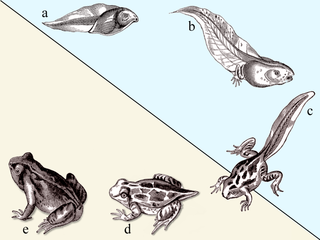
Ontogenetic niche shift is an ecological phenomenon where an organism changes its diet or habitat during its ontogeny (development). During the ontogenetic niche shifting an ecological niche of an individual changes its breadth and position. The best known representatives of taxa that exhibit some kind of the ontogenetic niche shift are fish, insects and amphibians. A niche shift is thought to be determined genetically, while also being irreversible. Important aspect of the ONS is the fact, that individuals of different stages of a population utilize different kind of resources and habitats. The term was introduced in a 1984 paper by biologists Earl E. Werner and James F. Gilliam.
















